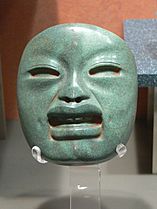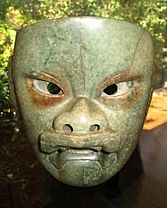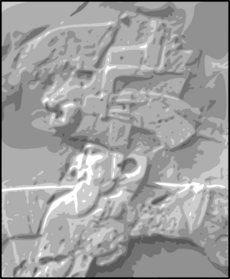Olmec alternative origin speculations facts for kids
The Olmec civilization was an ancient culture in Mesoamerica (modern-day Mexico). It existed from about 1600 BC to 400 BC. The Olmecs are known for their giant stone heads and advanced art.
Most experts agree that the Olmec civilization developed on its own in the Americas. They believe it was influenced by other cultures nearby. However, some people have different ideas about where the Olmecs came from. These are called alternative origin theories. They often suggest that the Olmecs had contact with people from the Old World (like Africa, Asia, or Europe).
These ideas are popular in some places. But most scientists and historians do not believe them. They see them as fringe theories because there is no strong evidence to support them.
Contents
What Experts Say About Olmec Origins
Most experts who study ancient Mesoamerica do not agree with the alternative origin theories. Many believe that promoting these ideas can be a form of racism. This is because it takes away from the achievements of indigenous Americans.
Scientists agree that the Olmecs and their amazing culture grew from influences already present in the Americas. There is no reliable proof that people from other parts of the world helped them. The Olmecs and their neighbors developed their own unique cultures. These cultures were based on a shared history of farming and traditions. They grew independently, without outside help.
Did the Olmecs Come From Africa?
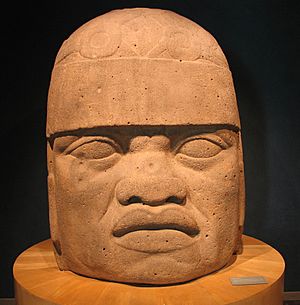
Some writers think the Olmecs were related to people from Africa. They base this idea mostly on the faces of Olmec statues. They also claim to have evidence from writing, genetics, and bones.
The idea started in 1862 with José Melgar. He found the first colossal head at Tres Zapotes. He wrote that this head belonged to a "Negro race." Later, writers like Leo Wiener and Ivan Van Sertima supported this view. Van Sertima even linked the Olmecs to the Mandé people of West Africa.
Claims About Olmec Writing
Some researchers say that Olmec writing is similar to African scripts. For example, Constantine Samuel Rafinesque thought Maya writing might be linked to Libyco-Berber writing from Africa. Others, like Leo Wiener, claimed that Olmec symbols look like those from the Vai script in Liberia. They pointed to symbols on the Tuxtla Statuette and the Cascajal Block.
However, experts who study Mesoamerican writing do not agree. They have made great progress in translating Maya writing. But they have not found any links between Olmec writing and African scripts.
What Genetic Studies Show
Scientists have done many genetic and immune system studies in the last 20 years. These studies have not found any proof of African people in the Americas before Christopher Columbus. Instead, genetic studies show that the first Americans were related to people from Melanesians and Australia.
What Bone Studies Show
Andrzej Wiercinski, a Polish scientist, claimed some Olmecs had African origins. He based this on skull evidence from two sites: Tlatilco and Cerro de las Mesas. Tlatilco is outside the main Olmec area, but it shows Olmec influence. Cerro de las Mesas is in the Olmec heartland.
Wiercinski compared these skulls to others from Poland, Mongolia, and Uganda. He then sorted each skull into different racial groups. He found that a small number of skulls from Tlatilco (14%) and Cerro de las Mesas (4.5%) had "Black" features.
He also compared the skulls to Olmec sculptures. For example, he said the giant Olmec heads looked like the "Dongolan" type (from Africa).
Most Mesoamerican experts do not accept Wiercinski's methods or conclusions. His method often forced Native American skulls into categories like "Caucasoid," "Negroid," or "Mongoloid." This can lead to wrong ideas. Other studies of Native American skulls show no real link to an African presence in America before Europeans arrived.
Did the Olmecs Come From China?
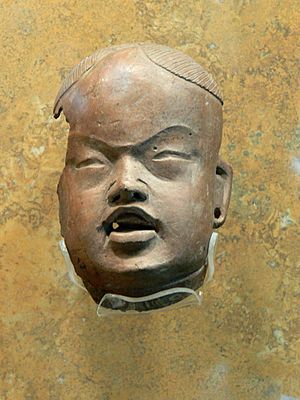
Some writers suggest that the Olmec civilization started with help from Chinese refugees. This idea often points to the end of the Shang Dynasty in China. In 1975, Betty Meggers of the Smithsonian Institution argued that Shang Chinese influences led to the Olmec civilization around 1200 BC.
In 1996, Mike Xu claimed that some Olmec tools called celts had Chinese writing on them. These claims are not supported by most Mesoamerican experts. Mike Xu's evidence included similar markings on Olmec pottery and Chinese oracle bones. He also noted that both cultures valued jade and knew about true North. However, these similarities are not enough to prove a connection.
Jaredite Origins and the Olmecs
The Book of Mormon is a religious text for members of the Latter Day Saint movement. It tells the story of the Jaredites, a group who left the Old World long ago and built a civilization in the Americas.
Some scholars who follow the Book of Mormon believe the Jaredites arrived in Mesoamerica. They suggest that the Olmec civilization might be the Jaredites. They point to how the Olmecs rose and fell, which roughly matches the Jaredite timeline in the Book of Mormon. However, mainstream historians and archaeologists do not accept this idea. They classify the Book of Mormon as a 19th-century American literary work.
Did the Olmecs Have Nordic Ancestry?
The explorer Thor Heyerdahl believed that some Olmec leaders had Nordic (Northern European) ancestors. He was partly inspired by a carved figure on La Venta Stela 3. This figure is nicknamed "Uncle Sam" and has a beard and a hooked nose. Some saw this as proof of ancient visitors from the Old World.
However, archaeologist Michael Coe and other experts disagree. They say it is wrong to use art to prove ethnic theories. They state that the Olmecs were American Indians, not people of African or Nordic descent.
Olmecs in Popular Culture
The short story "The Olmec Football Player" (1980) by Katherine MacLean is an interesting example. In this story, one of the giant Olmec heads is said to be an African-American college student. He traveled back in time while wearing his football helmet.


